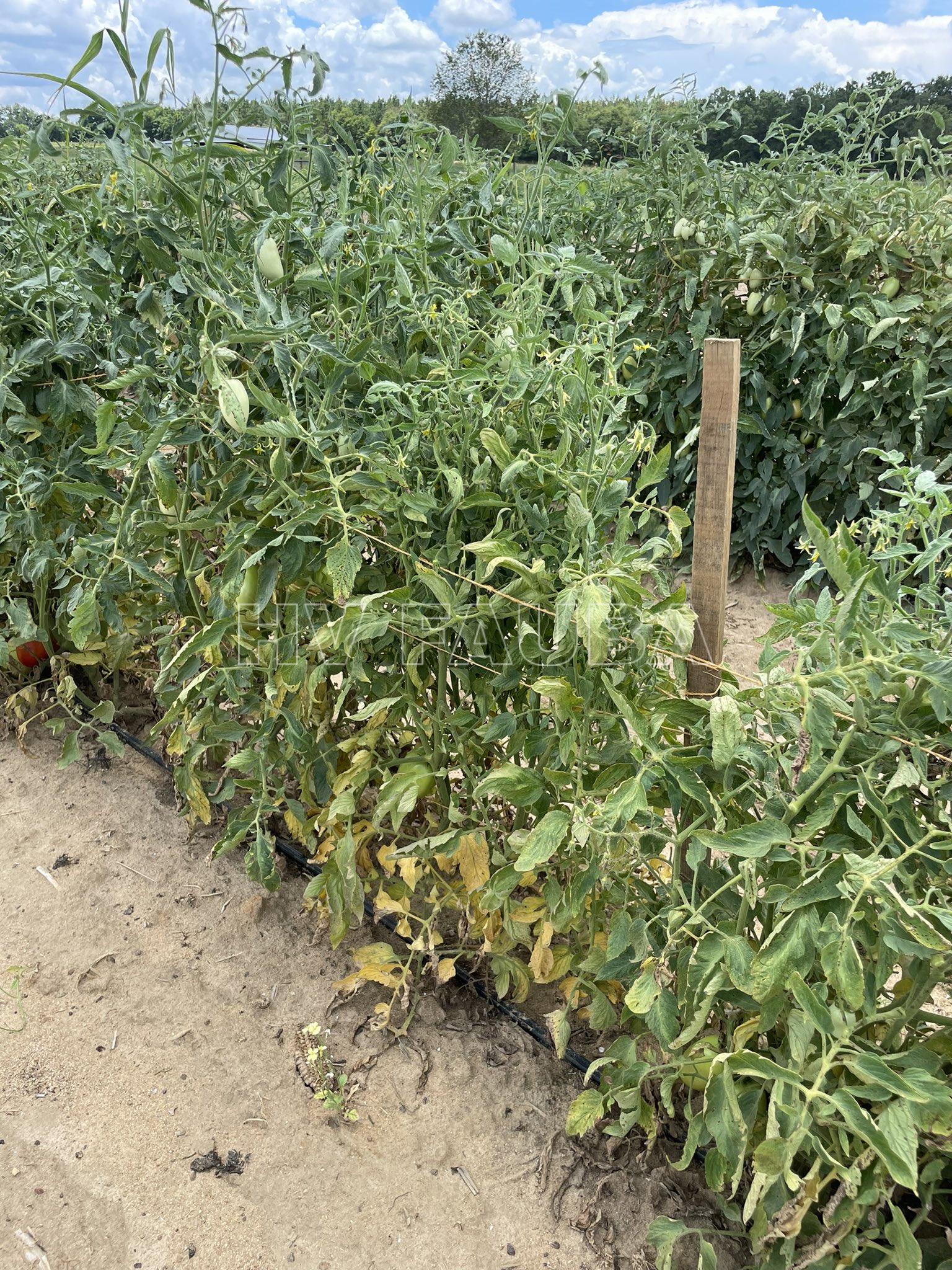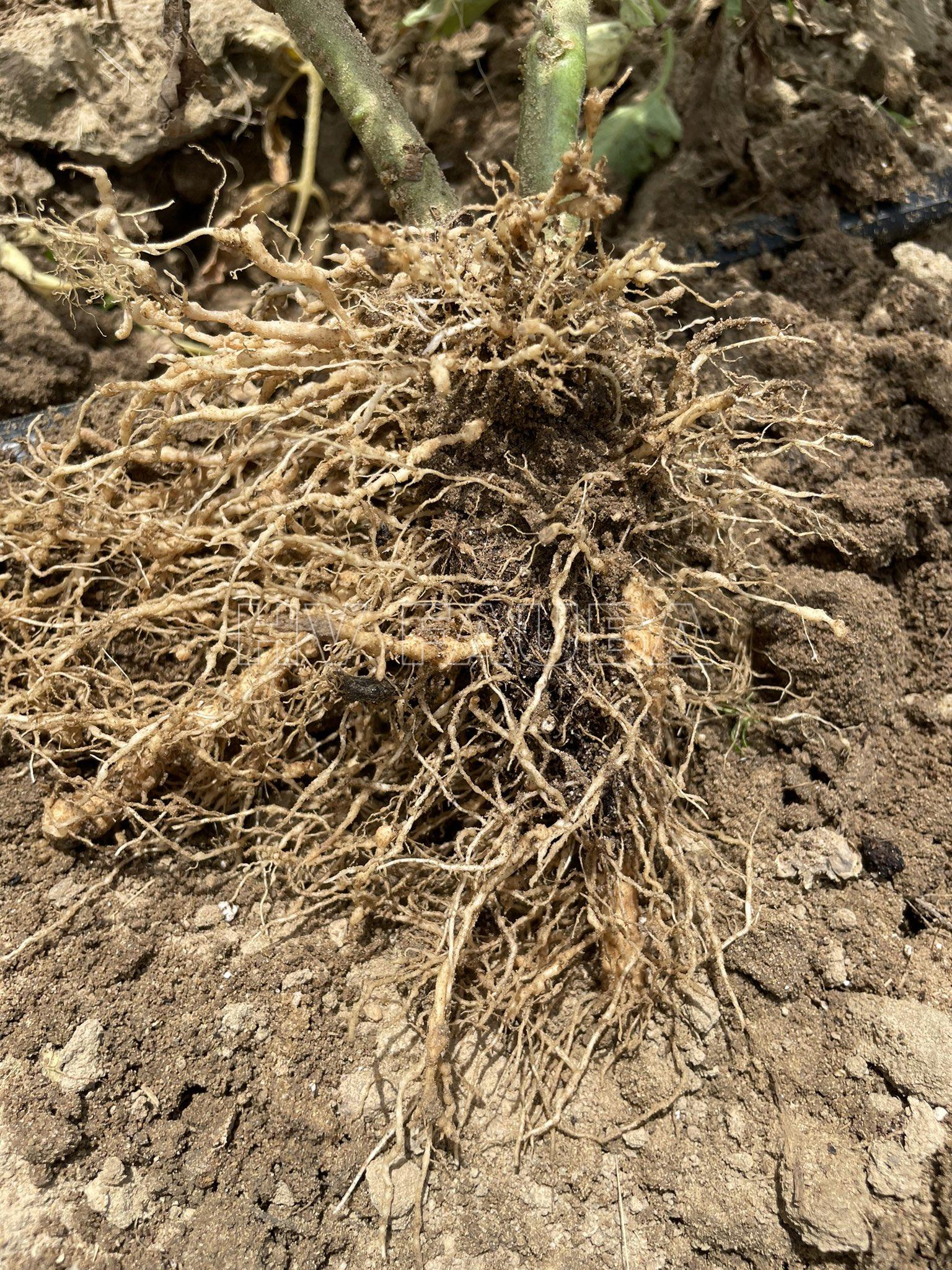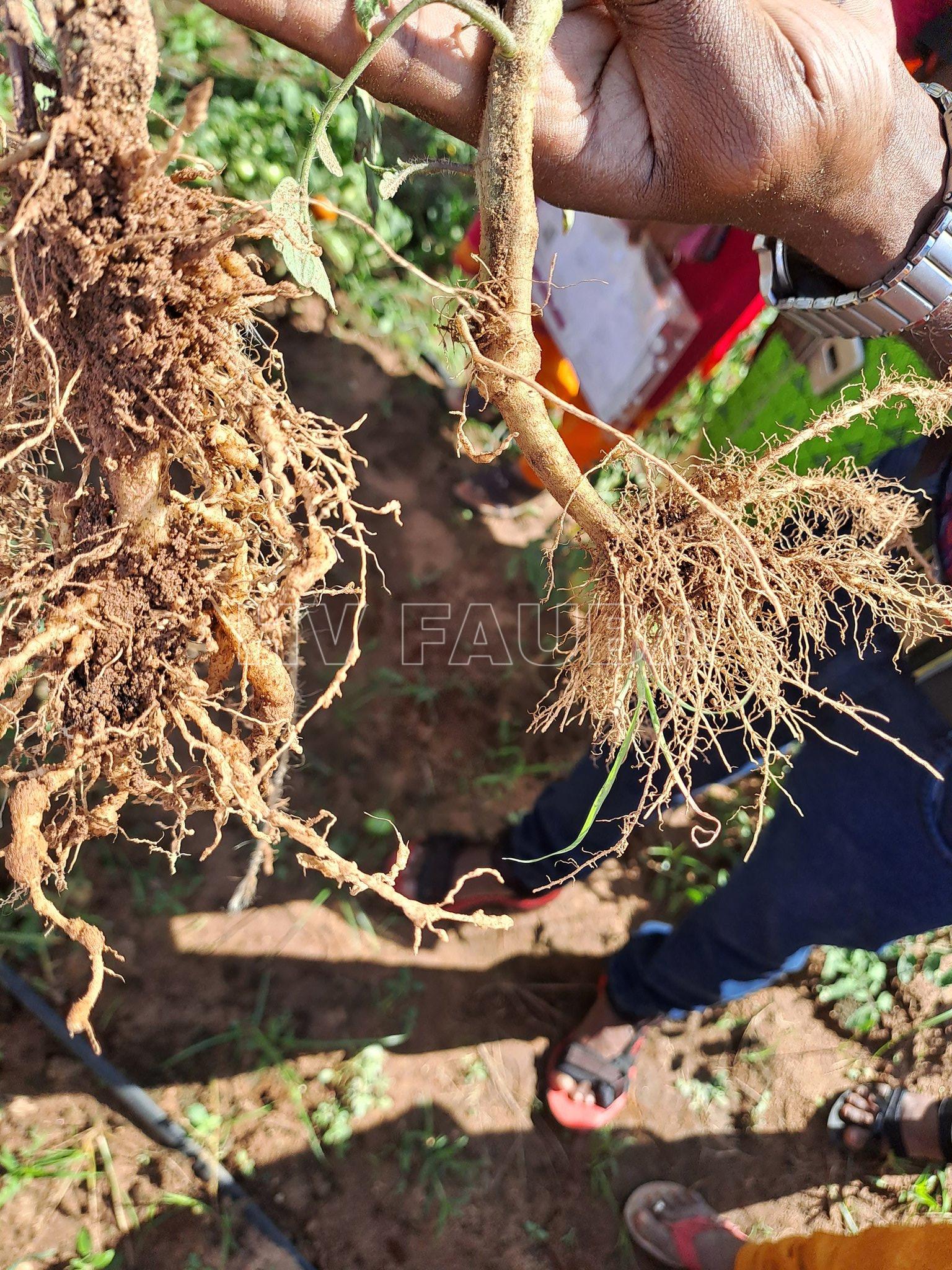.
Condición fitosanitaria: Plaga no cuarentenaria reglamentada
Grupo de cultivos: Hortícolas
Rango de hospedantes: Ampio, no específico, Cientos a miles de especies, incluyendo cutlivos extensivos de grano, pastos, hortalizas, frutales y numerosas malezas.
Especie hospedante: Tomate (Solanum lycopersicum)
.
Agente causal:
Meloidogyne javanica (Treub, 1885),
M. incognita (Kofoid & White, 1919)(southern root knot),
M. hapla Chitwood, 1949 (northern root knot),
M. arenaria (Neal, 1889)(peanut root knot),
M. enterlobii (guava root knot),
Meloidogyne spp. (~100 species)
.
Taxonomía: Eukaryota > Opisthokonta > Metazoa > Eumetazoa > Bilateria > Protostomia > Ecdysozoa > Nematoda > Chromadorea > Rhabditida > Tylenchina > Tylenchomorpha > Tylenchoidea > Meloidogynidae > Meloidogyninae > Meloidogyne > Meloidogyne incognita group
.
.
Sintomatología
- Autor: Ed Sikora
- Autor: Ed Sikora
- Autor: Clemen Oliveira
- Autor: Ricardo Oliva
.
.
Bibliografía
Alekcevetch JC, de Lima Passianotto AL, Ferreira EGC, et al. (2021) Genome-wide association study for resistance to the Meloidogyne javanica causing root-knot nematode in soybean. Theor Appl Genet 134: 777–792. doi: 10.1007/s00122-020-03723-9
, , , et al. (2022) Genetic variability and phylogenetic characterization of different populations of Meloidogyne izalcoensis and reaction of coffee genotypes to this new species detected in Brazil. Plant Pathology 00: 1– 15. doi: 10.1111/ppa.13686
Basso MF, Lourenço-Tessutti IT, Moreira-Pinto CE, et al. (2022) Overexpression of the GmEXPA1 gene reduces plant susceptibility to Meloidogyne incognita. Plant Cell Rep. doi: 10.1007/s00299-022-02941-3
Carraro-Lemes CF, Deuner CC, Arruda KMA, et al. (2022) Host reaction of wheat genotypes to Meloidogyne javanica and M. incognita. Trop. plant pathol. 47: 770–775. doi: 10.1007/s40858-022-00529-6
Devaraja KP, Ellur RK, Pankaj, et al. (2022) Response of rice genotypes to rice root-knot nematode (Meloidogyne graminicola) infection under varying temperature regimes. Plant Pathology 00: 1– 16. doi: 10.1111/ppa.13647
Doucet ME (1993) Consideraciones acerca del género Meloidogyne Goeldi, 1987 (Nemata: Tylenchida) y su situación en Argentina. Asociaciones y distribución. Agriscientia X: 63-80.
Figueiredo J, Vieira P, Abrantes I, Esteves I (2021) Detection of the root lesion nematode Pratylenchus penetrans in potato tubers. Plant Pathology 00: 1– 9. doi: 10.1111/ppa.13425
Forge T, Munro P, Midwood AJ, et al. (2021) Shifting Prevalence of Plant-Parasitic Nematodes in Orchards and Vineyards of the Okanagan Valley, British Columbia. Plant Health Progress 22: 113-121. doi: 10.1094/PHP-10-20-0079-RS
France RA, Abawi GS (1993) Interaction between Meloidogyne incognita and Fusarium oxysporum f. sp. phaseoli on selected bean genotypes. Journal of Nematology 26: 467-474.
Gheysen G, Mitchum MG (2019) Phytoparasitic Nematode Control of Plant Hormone Pathways. Plant Physiol. 179(4): 1212-1226. doi: 10.1104/pp.18.01067
Gorny AM, Hay FS, Esker P, Pethybridge SJ (2020) Spatial and spatiotemporal analysis of Meloidogyne hapla and Pratylenchus penetrans populations in commercial potato fields in New York, USA. Nematology 23(2)> 139-151. doi: 10.1163/15685411-bja10034
Gorny AM, Ye W, Cude S, Thiessen L (2021) Soybean Root-Knot Nematode: A Diagnostic Guide. Plant Health Progress 22: 164-175. doi: 10.1094/PHP-01-21-0005-DG
Goverse A, Mitchum MG (2022) At the molecular plant–nematode interface: New players and emerging paradigms. Current Opinion in Plant Biology 67: 102225. doi: 10.1016/j.pbi.2022.102225
Holderbaum MM, Santiago DC, Sera GH, et al. (2021) Penetration, development, and reproduction of Meloidogyne paranaensis in three Coffea arabica genotypes. Trop. plant pathol. 46: 528–535. doi: 10.1007/s40858-021-00449-x
Jain A, Wainer J, Huston DC, et al. (2022) Correction to: First report of a cyst nematode, Heterodera daverti, from Australia. Australasian Plant Dis. Notes 17: 39. doi: 10.1007/s13314-022-00485-9
Jain A, Huston DC, Wainer J, et al. (2023) Geographic range extension of hop cyst nematode, Heterodera humuli, from Tasmania to the Australian mainland. Australasian Plant Dis. Notes 18: 8. doi: 10.1007/s13314-023-00494-2
Khan M, Khan AU, Bogdanchikova N, Garibo D (2021) Antibacterial and Antifungal Studies of Biosynthesized Silver Nanoparticles against Plant Parasitic Nematode Meloidogyne incognita, Plant Pathogens Ralstonia solanacearum and Fusarium oxysporum. Molecules 26(9): 2462. doi: 10.3390/molecules26092462
Kumar A, Fitoussi N, Sanadhya P, et al. (2023) Two Candidate Meloidogyne javanica Effector Genes, MjShKT and MjPUT3: A Functional Investigation of Their Roles in Regulating Nematode Parasitism. Mol Plant Microbe Interact. 36(2): 79-94. doi: 10.1094/MPMI-10-22-0212-R
Lambert K, Bekal S (2002) Introduction to Plant-Parasitic Nematodes. The Plant Health Instructor. doi: 10.1094/PHI-I-2002-1218-01
Lüdke D, Sakai T, Kourelis J, et al. (2023) A root-specific NLR network confers resistance to plant parasitic nematodes. bioRxiv 2023.12.14.571630; doi: 10.1101/2023.12.14.571630
Mandal HR, Katel S, Subedi S, Shrestha J (2021) Plant Parasitic Nematodes and their management in crop production: a review. Journal of Agriculture and Natural Resources 4(2): 327–338. doi: 10.3126/janr.v4i2.33950
Marquez J, Hajihassani A (2022) Occurrence of the Root-Knot Nematode Meloidogyne haplanaria in Vegetable Fields of South Georgia, U.S.A. Plant Health Progress 23: 378-380. doi: 10.1094/PHP-04-22-0034-SC
Marquez J, Hajihassani A (2023) Identification and Virulence of Five Isolates of Root-Knot Nematode Meloidogyne floridensis on Vegetables. Plant Disease:PDIS06221331RE. doi: 10.1094/PDIS-06-22-1331-RE
Mattos VS, Leite RR, Santos MFA, et al. (2021) Genetic diversity of Meloidogyne spp. from rice and identification of multi-resistant sources in Oryza spp. accessions. Plant Pathol. 00: 1– 12. doi: 10.1111/ppa.13438
Mbatyoti A, De Beer A, Daneel MS, et al. (2021) The host status of glyphosate-tolerant soybean genotypes to Meloidogyne incognita and Pratylenchus infection. Trop. plant pathol. 46: 336–349. doi: 10.1007/s40858-020-00416-y
Mitchum MG, Hussey RS, Baum TJ, Wang X, Elling AA, Wubben M, Davis EL (2013) Nematode effector proteins: an emerging paradigm of parasitism. New Phytol 199: 879-894. doi: 10.1111/nph.12323
Mitkowski NA, Abawi GS (2003) Root-knot nematodes. The Plant Health Instructor. doi: 10.1094/PHI-I-2003-0917-01
Nnamdi C, Grey TL, Hajihassani H (2022) Root-knot nematode management for pepper and squash rotations using plasticulture systems with fumigants and non-fumigant nematicides. Crop Protection 152: 105844. doi: 10.1016/j.cropro.2021.105844
(2023) Potato cyst nematodes: A persistent and fearsome foe. Plant Pathology 72: 1541–1556. doi: 10.1111/ppa.13779
Ozdemir S, Zadegan SB, Sultana MS, et al. (2024) Regulation and functions of long non-coding RNAs during Meloidogyne incognita parasitism of tomato. Mol Plant Microbe Interact. 38(1):72-83. doi: 10.1094/MPMI-10-24-0140-R
Sahebani N, Hadavi N (2008) Biological control of the root-knot nematode Meloidogyne javanica by Trichoderma harzianum. Soil Biology and Biochemistry 40: 2016-2020. doi: 10.1016/j.soilbio.2008.03.011
Sato K, Uehara T, Holbein J, et al. (2021) Transcriptomic Analysis of Resistant and Susceptible Responses in a New Model Root-Knot Nematode Infection System Using Solanum torvum and Meloidogyne arenaria. Front. Plant Sci. 12: 680151. doi: 10.3389/fpls.2021.680151
Toju H, Tanaka Y (2019) Consortia of anti-nematode fungi and bacteria in the rhizosphere of soybean plants attacked by root-knot nematodes. R Soc Open Sci. 6(3): 181693. doi: 10.1098/rsos.181693
, , , et al. (2023) Characterization and pathogenicity of Pratylenchus vandenbergae stat. nov. (Tylenchina: Pratylenchidae), a highly pathogenic root-lesion nematode parasitizing crops in Kenya and South Africa. Plant Pathology 00: 1–18. doi: 10.1111/ppa.13836
Wen TY, Wu XQ, Hu LJ, et al. (2021) A novel pine wood nematode effector, BxSCD1, suppresses plant immunity and interacts with an ethylene-forming enzyme in pine. Mol Plant Pathol. doi: 10.1111/mpp.13121
Wolfgang A, Taffner J, Guimarães RA, et al. (2019) Novel Strategies for Soil-Borne Diseases: Exploiting the Microbiome and Volatile-Based Mechanisms Toward Controlling Meloidogyne-Based Disease Complexes. Front. Microbiol. 10: 1296. doi: 10.3389/fmicb.2019.01296
Yang T, Xin Y, Liu T, et al. (2021) Bacterial volatile-mediated suppression of root-knot nematode (Meloidogyne incognita). Plant Disease. doi: 10.1094/PDIS-06-21-1139-RE
, , (2023) Metabolic variations in root tissues and rhizosphere soils of weak host plants potently lead to distinct host status and chemotaxis regulation of Meloidogyne incognita in intercropping. Molecular Plant Pathology 00: 1–16. doi: 10.1111/mpp.13396



